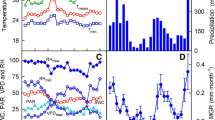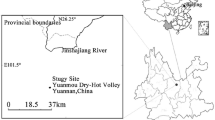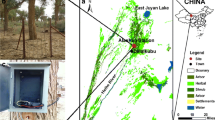Abstract
Adaptive mechanisms in Hedysarum mongolicum to dry and hot conditions in desert areas remain unclear. In this work, the diurnal and seasonal dynamics of sap flow in H. mongolicum, endemic to a semi-arid desert shrubland ecosystem, were studied. Stem sap flow was continuously monitored with heat balance sensors from June to October, 2012. Diurnal pattern in sap flow per stem area (J s) revealed a clear seasonal trend, with J s peaking earlier in summer (~10:00 h, 3 h before solar noon, R s), than in autumn (at roughly the same time as R s). Seasonally, J s was positively correlated to leaf area index. Excluding effects of phenology, volumetric soil water content (VWC) affected J s the greatest. In general, VWC was revealed to regulate the degree of response of J s to meteorological factors [R s, temperature T, and water vapor pressure deficit (VPD)], with sap flow being more responsive to these factors when VWC was high (>0.09 m3 m−3). Under low VWC (<0.09 m3 m−3), positive response of J s to the meteorological factors became saturated (leveled off) or declined when dry-hot conditions exceeded an hourly mean T, R s, and VPD of 24 °C, 700 W m−2, and 2.1 kPa, respectively. The results showed that H. mongolicum shrubs adapt to hot-dry or water-limited conditions in summer by closing their stomata in mid-morning and reducing the sensitivity in J s to T, R s, and VPD. The understanding of adaptive mechanisms in desert shrub species could potentially provide important baseline information towards the ecological restoration and sustainable development of arid- and semi-arid ecosystems.





Similar content being viewed by others
References
Alarcón JJ, Ortuño MF, Nicolás E, Torres R, Torrecillas A (2005) Compensation heat-pulse measurements of sap flow for estimating transpiration in young lemon trees. Biol Plant 49:527–532
Berndtsson R, Nodomi K, Yasuda H, Persso T, Chen H, Jinno K (1996) Soil water and temperature patterns in an arid desert dune sand. J Hydrol 185:221–240
Bernier PY, Breda N, Granier A, Raulier F, Mathieu F (2002) Validation of a canopy gas exchange model and duration of a soil water modifier for transpiration for sugar maple (Acer saccharum Marsh.) using sap flow density measurements. For Ecol Manag 163:185–196
Cavanaugh ML, Kurc SA, Scott RL (2011) Evapotranspiration partitioning in semiarid shrubland ecosystems: a two-site e valuation of soil moisture control on transpiration. Ecohydrology 4:671–681
Čermák J, Cienciala E, Kučera J, Lindroth A, Bednářová E (1995) Individual variation of sap-flow rate in large pine and spruce trees and stand transpiration: a pilot study at the central NOPEX site. J Hydrol 168:17–27
Čermák J, Kučera J, Nadezhdina N (2004) Sap flow measurements with some thermodynamic methods, flow integration within trees and scaling up from sample trees to entire forest stands. Trees 18:529–546
Chang X, Zhao W, He Z (2014) Radial pattern of sap flow and response to microclimate and soil moisture in Qinghai spruce (Picea crassifolia) in the upper Heihe River Basin of arid northwestern China. Agr For Meteorol 187:14–21
Chen L, Zhang Z, Li Z, Tang J, Caldwell P, Zhang W (2011) Biophysical control of whole tree transpiration under an urban environment in Northern China. J Hydrol 402:388–400
Chirino E, Bellot J, Sánchez JR (2011) Daily sap flow rate as an indicator of drought avoidance mechanisms in five Mediterranean perennial species in semiarid southeastern Spain. Trees 25:593–606
Donovan LA, Grisé DJ, West JB, Pappert RA, Alder NN, Richards JH (1999) Predawn disequilibrium between plant and soil water potentials in two cold-desert shrubs. Oecologia 120:209–217
Du S, Wang Y, Kume T, Zhang J, Otsuki K, Yamanaka N, Liu G (2011) Sapflow characteristics and climatic responses in three forest species in the semiarid Loess Plateau region of China. Agr For Meteorol 151:1–10
Dynamax (2005) Dynagage® installation and operation manual. TX, Dynamax, Houston, p 36
Gazal RM, Scott RL, Goodrich DC, Williams DG (2006) Controls on transpiration in a semiarid riparian cottonwood forest. Agric For Meteorol 137:56–67
Goff JA, Gratch S (1946) Low-pressure properties of water from −160 to 212 F. Trans Am Soc Heat Vent Eng 52:95–122
Guan DX, Zhang XJ, Yuan FH, Chen NN, Wang AZ, Wu JB, Jin CJ (2012) The relationship between sap flow of intercropped young poplar trees (Populus × euramericana cv. N3016) and environmental factors in a semiarid region of northeastern China. Hydrol Process 26:2925–2937
Huang L, Zhang ZS, Li XR (2010) Sap flow of Artemisia ordosica and the influence of environmental factors in a revegetated desert area: tengger Desert, China. Hydrol Process 24:1248–1253
Kang S, Hua X, Jeriec P, Zhang J (2003) The effects of partial rootzone drying on root, trunk sap flow and water balance in an irrigated pear (Pyrus communis L.) orchard. J Hydrol 280:192–206
Kool D, Agam N, Lazarovitch N, Heitman JL, Sauer TJ, Ben-Gal A (2014) A review of approaches for evapotranspiration partitioning. Agr For Meteorol 184:56–70
Köstner BMM, Schulze ED, Kelliher FM, Hollinger DY, Byers JN, Hunt JE, McSeveny TM, Meserth R, Weir PL (1992) Transpiration and canopy conductance in a pristine broad-leaved forest of Nothofagus: an analysis of xylem sap flow and eddy correlation measurements. Oecologia 91:350–359
Kramer PJ, Boyer JS (1995) Water relations of plants and soils. Academic Press, San Diego, pp 19–21
Lagergren F, Lindroth A (2002) Transpiration response to soil moisture in pine and spruce trees in Sweden. Agric For Meteorol 112:67–85
Lambers H, Chapin FS III, Pons TL (1998) Plant physiological ecology. Springer, New York, pp 197–198
Limousin JM, Rambal S, Ourcival JM, Rocheteau A, Joffre R, Rodriguez-Cortina R (2009) Long-term transpiration change with rainfall decline in a Mediterranean Quercus ilex forest. Global Change Biol 15:2163–2175
Liu X, Kang S, Li F (2009) Simulation of artificial neural network model for trunk sap flow of Pyrus pyrifolia and its comparison with multiple-linear regression. Agr Water Manag 96:939–945
Liu B, Zhao W, Jin B (2011) The response of sap flow in desert shrubs to environmental variables in an arid region of China. Ecohydrology 4:448–457
Martínez-Ferri E, Balaguer L, Valladares F, Chico JM, Manrique E (2000) Energy dissipation in drought-avoiding and drought-tolerant tree species at midday during the Mediterranean summer. Tree Physiol 20:131–138
McVicar TR, Li LT, Van Niel TG, Zhang L, Li R, Yang QK, Zhang XP, Mu XM, Wen ZM, Liu WZ, Zhao YA, Liu ZH, Gao P (2007) Developing a decision support tool for China’s re-vegetation program: simulating regional impacts of afforestation on average annual streamflow in the Loess Plateau. For Ecol Manag 251:65–81
Monclus R, Dreyer E, Villar M, Delmotte FM, Delay D, Petit JM, Barbaroux C, Thiec D, Bréchet C, Brignolas F (2006) Impact of drought on productivity and water use efficiency in 29 genotypes of Populus deltoides × Populus nigra. New Phytol 169:765–777
Nasr Z, Woo SY, Zineddine M, Khaldi A, Rejeb MN (2011) Sap flow estimates of Quercus suber according to climatic conditions in north Tunisia. Afr J Agr Res 6:4705–4710
O’Brien JJ, Oberbauer SF, Clark DB (2004) Whole tree xylem sap flow responses to multiple environmental variables in a wet tropical forest. Plant Cell Environ 27:551–567
O’Grady AP, Worledge D, Battaglia M (2008) Constraints on transpiration of Eucalyptus globulus in southern Tasmania, Australia. Agric For Meteorol 148:453–465
Oren R, Phillips N, Ewers BE, Pataki DE, Megonigal JP (1999) Sap-flux-scaled transpiration responses to light, vapor pressure deficit, and leaf area reduction in a flooded Taxodium distichum forest. Tree Physiol 19:337–347
Picotte JJ, Rosenthal DM, Rhode JM, Cruzan MB (2007) Plastic responses to temporal va riation in moisture availability: consequences for water use efficiency and plant performance. Oecologia 153:821–832
Qu YP, Kang SZ, Li FS, Zhang JH, Xia GM, Li WC (2007) Xylem sap flows of irrigated Tamarix elongata Ledeb and the influence of environmental factors in the desert region of Northwest China. Hydrol Process 21:1363–1369
Reyes-Acosta JL, Lubczynski MW (2014) Optimization of dry-season sap flow measurements in an oak semi-arid open woodland in Spain. Ecohydrology 7:258–277
Schwinning S, Sala OE (2004) Hierarchy of response to resource pluses in arid and semi-arid ecosystems. Oecologia 130:345–355
She D, Xia Y, Shao M, Peng S, Yu S (2013) Transpiration and canopy conductance of Caragana korshinskii trees in response to soil moisture in sand land of China. Agrofor Syst 87:667–678
Sun J (2002) Provenance of loess material and formation of loess deposits on the Chinese Loess Plateau. Earth Planet Sci Lett 203:845–859
Van den Bilcke N, De Smedt S, Simbo DJ, Samson R (2013) Sap flow and water use in African baobab (Adansonia digitata L.) seedlings in response to drought stress. S Afr J Bot 88:438–446
Xia GM, Kang SZ, Li FS, Zhang JH, Zhou QY (2008) Diurnal and seasonal variations of sap flow of Caragana korshinskii in the arid desert region of north-west China. Hydrol Process 22:1197–1205
Xiao C, Jia F, Zhou G, Jiang Y (2002) Response of photosynthesis, morphology and growth of edysarum mongolicum seedlings to simulated precipitation change in Maowusu sandland. J Environ Sci 14:277–283
Xu H, Li H (2006) Water-use strategy of three central Asian desert shrubs and their responses to rain pulse events. Plant Soil 285:5–17
Yan MJ, Yamanaka N, Yamamoto F, Du S (2010) Responses of leaf gas exchange, water relations, and water consumption in seedlings of four semiarid tree species to soil drying. Acta Physiol Plant 32:183–189
Yin L, Zhou Y, Huang J, Wenninger J, Hou G, Zhang E, Wang X, Dong J, Zhang J, Uhlenbrook S (2014) Dynamics of willow tree (Salix matsudana) water use and its response to environmental factors in the semi-arid Hailiutu River catchment, Northwest China. Environ Earth Sci 71:4997–5006
Yoshifuji N, Komatsu H, Kumagai T, Tanaka N, Tantasirin C, Suzuki M (2011) Interannual variation in transpiration onset and its predictive indicator for a tropical deciduous forest in northern Thailand based on 8-year sap-flow records. Ecohydrology 4:225–235
Zeppel M, Macinnis-Ng CMO, Ford CR, Eamus D (2008) The response of sap flow responses to pulses of rain in a temperate Australian woodland. Plant Soil 305:121–130
Zha TS, Li CY, Kellomäki Peltola H, Wang KY, Zhang YQ (2013) Controls of Evapotranspiration and CO2 Fluxes from Scots Pine by Surface Conductance and Abiotic Factors. PLoS ONE 8:e69027
Zhang L, Luo TX (2004) Advances in ecological studies on leaf lifespan and associated leaf traits. Acta Phytoecol Sin 28:844–852 (in Chinese with English Abstract)
Zhao WZ, Liu B (2010) The response of sap flow in shrubs to rainfall pulses in the desert region of China. Agr For Meteorol 150:1297–1306
Zhao Y, Yuan W, Sun B, Yang Y, Li J, Li J, Cao B, Zhong H (2010) Root distribution of three desert shrubs and soil moisture in Mu Us sand land. Res Soil Water Conserv 17:129–133 (in Chinese with English Abstract)
Acknowledgment
This research was financially supported with grants from the National Basic Research Program of China (Project No.: 2013CB429901), and National Natural Science Foundation of China (NSFC, Project No.’s: 31270755 and 31361130340), and the Academy of Finland (Project No.: 14921). This work is related to the ongoing Finnish-Chinese collaborative research project, EXTREME, between Beijing Forestry University and the University of Eastern Finland. Thanks go to Huishu Shi, Yuming Zhang, Wei Feng, Sijing Li, Zhihao Chen, Siling Tang, Yajuan Wu, and Yuan Li for their assistance with the collection of field measurements and instrumentation maintenance.
Conflict of interest
The authors declare that they have no conflict of interest.
Author information
Authors and Affiliations
Corresponding author
Rights and permissions
About this article
Cite this article
Qian, D., Zha, T., Jia, X. et al. Adaptive, water-conserving strategies in Hedysarum mongolicum endemic to a desert shrubland ecosystem. Environ Earth Sci 74, 6039–6046 (2015). https://doi.org/10.1007/s12665-015-4627-9
Received:
Accepted:
Published:
Issue Date:
DOI: https://doi.org/10.1007/s12665-015-4627-9




